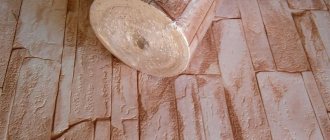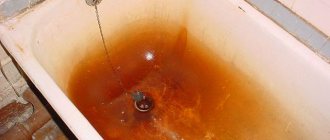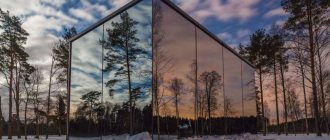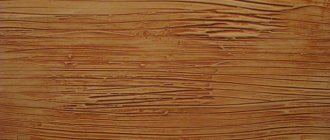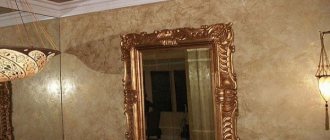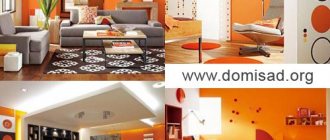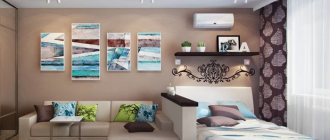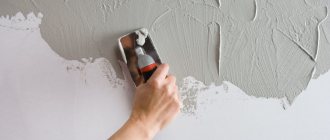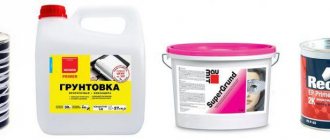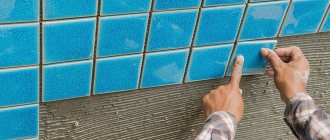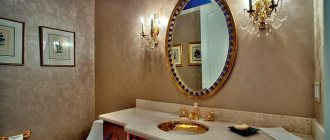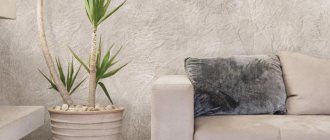Advantages of leather as a finishing material
This is a breathable material. This is additional thermal insulation, pleasant to the touch.
Air circulates through the pores, maintaining a light aroma in the apartment.
Leather wall coverings have the following advantages:
- sound insulation;
- thermal insulation;
- sophisticated look;
- reliability;
- long period of use guaranteed by the manufacturer;
- environmental friendliness;
- fire resistance enhanced by chemicals.
Advantages and variety of materials
Such walls look prestigious and expensive.
But you shouldn’t decorate the room entirely with leather wallpaper.
Leather flooring
Lay a piece of leather on the floor and stand on it with your bare feet. In just a moment you will feel extraordinary warmth and comfort, because this is a living natural material and its value is simply limitless. Leather products have been valued since the Renaissance. They are extremely wear-resistant, durable and reliable.
Floors are covered with leather in libraries, bedrooms and offices. Due to the nature of leather, smoking cannot quickly absorb any odors in a room with leather floors. In hallways, kitchens, children's rooms and rooms with heavy traffic, it is not recommended to lay leather flooring. In large rooms, it takes a lot of money to decorate the walls and ceilings. In this case, a leather rug or a combination of fur and leather will look beautiful.
Question 3: how does decorative plaster imitate leather?
The plaster imitates the rough and textured skin of a snake or crocodile. Using tools, the master applies a pattern to the wall using the raw plaster mixture and draws out the scales. The finish looks impressive in black, green, orange tones. After 5 days of drying, the pattern on the wall becomes durable.
Options for imitation genuine leather
Plaster for leather products - decorates the wall, does not require additional decor. The type of pattern on the wall is chosen by the owners of the apartment.
Finishing is carried out with a mixture based on gypsum or acrylic.
To recreate the scales, rubber molds and decorative rollers are used. The effect of soft skin is achieved with film, paper and other devices.
Painting, varnishing, and glazing make the coating realistic. This is achieved by texture and smooth transition of tones. The range of shades is unlimited. This creates beautiful effects in individual areas.
Plaster
The finish can be applied regardless of the room. In small apartments, partial use of the coating looks more appropriate - application to one of the four walls, to place accents without overloading the room. These inserts play an important role in the perception of the interior.
Leather wall panels: types of wall decor
With the help of 3D leather panels, a variety of stylish interiors are created in the house. This could be a cozy corner in the bedroom or a safe area in a child's room. For all these interiors, wall decor made from eco-leather will be a practical and economical solution.
Leather wall panels are most often produced in square or rectangular shapes, and can have a variety of colors and surface designs. Made in a soft version, products for wall decoration made of eco-leather consist of three layers. For the base, a PVC board, plywood or hardboard can be used. The plastic base may sometimes have a self-adhesive layer. Thus, the manufacturer makes installation of its products simple and convenient.
Sintepon, foam rubber or polyurethane foam can be used as a filler that is fixed to the base.
Leather panels for walls filled with padding polyester will not deform or sag, since padding polyester is very light and it is not difficult to distribute it evenly over the surface.
Foam rubber is a denser filler, but it can be used to make wall decor more voluminous. It is recommended to decorate children's rooms with slabs filled with foam rubber. This finish can protect babies from injury.
Polyurethane foam is a relatively new filler, but has already proven itself on the positive side. It is non-flammable and completely safe for health. To its positive qualities we can add waterproofness, resistance to rotting, light weight and ease of handling. However, this filler is much stiffer than foam rubber and padding polyester.
In the case of smooth leather panels there is no filler. But this does not mean that smooth wall products are less decorative. They have a rich palette of shades. The surface of eco-leather is decorated with perforation and embossing. Patterns on the panels can range from simple florals to fantasy abstractions.
The base, with or without filler glued to it, is covered with eco-leather. Despite their low cost, leather wall panels with such upholstery look noble and impressive. They are often used not only in residential buildings and apartments, but also decorate bars, nightclubs and other public spaces with high traffic. The high strength and wear resistance of the panel surfaces make them a suitable finishing material for such establishments.
Soft leather panels are often decorated with carriage binding. This technique allows you to create different patterns. For 3D leather panels, perforated leather can be used. This option is suitable for cases where good air circulation is required.
Some manufacturers create leather wall panels with a self-adhesive backing. This option for wall decor is used in places where it is convenient to mount products without the use of glue. You can see all these wall decors, as well as soft panels, in our show room in Moscow “live” and on our website online in the online store catalog.
Leather panels for walls: characteristics
Eco-leather wall decors are very simple and easy to care for. However, to ensure a long service life, certain care rules must be followed:
· They must be wiped from dust with a soft, damp cloth;
· Do not use a brush that is too hard to care for leather panels;
· Traces of felt-tip pens are erased from the panels with soapy water;
· For stubborn stains, you should use special products for eco-leather;
· The use of bleaching and abrasive agents is prohibited.
If these rules are followed, leather products will last for many years. But durability is not the only advantage of this finishing decorative material.
All wall decors have thermal insulation and noise-absorbing characteristics to a greater or lesser extent. However, leather panels, especially in the soft version, are leaders in this indicator. That is why bars, karaoke clubs, and home theaters are often decorated with such panels.
Soft leather products make it easy to ensure safety in a child's room. The child will not be injured if he falls or collides with a wall.
Leather products are easy to repair if damaged. The damaged element is simply removed and replaced with a whole one.
Their installation is quite simple and does not require outside help. When installing on a lathing, there is no need to level and prepare the surface to be finished. However, it is still recommended to treat it with an anti-mold and mildew agent.
But more often they are simply glued to the wall using PVA glue or liquid nails. For this method, the walls will have to be plastered, leveled and primed. In the case of finishing the entire wall with leather panels, it is better to start work from the top row.
If they have a self-adhesive base, then their installation will involve peeling off the protective layer and firmly pressing the product against the wall.
Question 4: what to choose in the interior – leather or its imitation
A large selection of wallpaper requires a serious approach. The customer needs to take into account the interior of the room and imagine the final result.
Popular options:
- Imitation python skin. The scales of the relief are voluminous and uneven. Snake skin complements the design well and makes it unique. The walls go well with the marine theme in the interior.
- Zebra imitation. The decoration is in harmony with minimalism and monochrome. This area becomes the focal point of the room. Genuine leather wallpaper is combined with other animalistic wall elements in the loft style.
- Leopard imitation. Women like this option.
- Embossed leather. Gold or silver embossing is often used in production. Relevant for palace style designs. The wallpaper combines palace luxury and modernity.
Available materials
An acrylic mixture can be used as a decorative fine-grained plaster in imitation of crocodile skin. It contains quartz and marble chips. Fractional inclusions can be different in size, which allows you to get a textured or smooth surface. Such compositions can be used for decorative interior and exterior work. The bases can be: chipboard, cardboard, mineral materials.
Gypsum mixtures are also suitable for decorating walls to look like leather. They can be used exclusively on interior walls, since the compositions have a high degree of hygroscopicity. The maximum layer thickness can be 5 cm.
This plaster should be worked as quickly as possible, as it hardens within a short time. Final drying can be expected after 4 hours. In addition to decorative characteristics, after applying such plaster, the wall also begins to have thermal insulation properties. Gypsum decorative plaster does not shrink and is environmentally friendly and fireproof. It is ready to serve for quite a long time and can be operated at low temperatures.
Question 5: what to combine leather surfaces with
At first, designers used leather wallpaper to decorate foyers and restaurants. Now the material is used for finishing apartments and rooms in private houses. Popularity and convenience increase demand.
You can combine leather surfaces with any texture. The beauty is emphasized by natural wood, stone, glass, and metals.
The main condition is to avoid oversaturation. A lot of skin is bad form. Textiles, wood and other finishing materials should prevail in the interior. It is important to correctly emphasize, balance, and at the same time not drown out what you want to highlight.
Combination in interiors
Leather furniture
It doesn’t have to be a “hello from the 90s” leather sofa; chair seats, headboards, poufs, and chair seats can also be finished with this material. Preference is given to brown, gray, black and pastel shades - they look richer and more impressive. At the peak of popularity are burgundy and olive colors. If you dream of an individual set, leather can be combined with other textures - fabric, fur, metal, wooden elements.
Glamor lovers decorate the leather with rhinestones, embossing, embroidery, varnishing and perforation. You can paint the surface in extreme shades, decorate it with prints, stencil designs - designers can bring even the most sophisticated imagination to life.
However, leather trim is typical not only for upholstered furniture. Chests of drawers, cabinets, cabinet doors, coffee tables, and countertops are also decorated with this material. Was the experiment a success? - judge for yourself.
Agree, leather-clad bookshelves, wardrobes and even refrigerators are not found in every home! For this, only high quality materials are used, they are pre-treated with wax and special impregnations, and patinated to protect them from moisture, dirt and mechanical damage.
Imitations of shagreen are used for drawers and suitcases, safes, and chair backs; more exotic materials (crocodile, eel, stingray, ostrich) are suitable for a massive set that will be the center of the composition and simply cannot help but attract attention.
Interior finishing options
You can partially cover a room with wallpaper. The decoration method depends only on the owners. It is advisable to combine leather with natural elements to give the room a noble look.
Panels or wallpaper are complemented with wood and clapboard. There are many options for implementing stylistic ideas.
Finishing methods
The method of working depends on the material. No surface preparation is required in any situation. It is enough that the walls are smooth, without large recesses and bulges. The tile is fixed with adhesive. The panels are attached to guides, the wallpaper is attached with glue for heavy materials.
What to pay attention to
Crocodile skin effect
There are rules that are followed when working with leather wallpaper. Violation of technology will lead to damage to the material and appearance of the wall.
To prevent the problem you need to follow the rules:
- Do not cover all walls. Full decoration is not a mistake, but designers advise making only part of the room leather. Balance the catchy finish with the remaining elements.
- Do not use prints, refuse to combine several types and patterns of leather-look wallpaper in one design. It is better to refrain from combining crocodile and snake prints. One option is enough.
- Do not use metal parts or varnished elements. This overloads the design.
- Refuse wallpaper in a frame or panel. Material is an independent element. Additional highlighting is a design mistake.
Soft decorative panels
A bright way to decorate. With soft panels you can focus attention on one wall, the head of the bed, or a niche.
Panels are a rigid base of a rectangular or square shape, which is covered with leather. With a soft insert inside, which makes them embossed. On top – natural or artificial leather. In addition to the main parts, manufacturers sell accessories - square, triangular, and narrow stripes. Expensive slabs are decorated with Swarovski stones. The panels are secured with polyurethane foam.
Leather three-dimensional wall tiles
Advantages of decorating with 3D panels:
- Exclusivity - the correct use of the material indicates good taste, the status of the owner, and his compliance with fashion. Decorating with 3D panels is not often found in apartments.
- Versatility - the panels are suitable for bedrooms, living rooms, hallways, children's rooms and kitchens. The scale of decoration can vary: more in the living room, less in the bedroom.
- Practicality - the durable coating can withstand heavy loads, it is easy to remove stains and marks from dirty hands.
- Soundproofing. The panels absorb noise well, which is important for a child’s room, bedroom, or home theater room.
- There is no need to make the walls smooth. The upholstery hides minor imperfections. You still can't do without basic alignment.
- Speed of work. The panels are quickly installed, without dust and dirt.
- Decorative. You can choose the upholstery method - leatherette, natural material or fabric. Select the shade and texture of the surface.
- Safe operation.
- Coziness, comfort. Soft panels make the room cozy and beautiful.
Of interest is the large selection of shades and textures, the possibility of obtaining the intended design. Decorative panels allow you to make repairs without hiring craftsmen.
Leather drapery, tight fitting
Finishing is also realized in other techniques - drapery and covering. When draping, soft surfaces are not obtained. Usually the material is simply glued to a flat surface.
Upholstering walls with leather makes it possible to obtain soft walls. They do it like this:
- Slats are attached to the walls, padding polyester and foam rubber are placed between them.
- The leather is nailed onto the top rail, its edge is folded in, then secured with a construction stapler.
- Afterwards, the material is stretched and nailed to the bottom and side slats.
- If the finishing area is small, then intermediate fastenings will not be needed.
The slats can be replaced with a profile equipped with clamps under the skin. This will make installation easier. The result will be a smoother wall, without folds.
Crinkled (Turkish) leather effect
This type of decorative plaster differs from “crocodile skin” both in appearance and in the technique of execution.
To achieve the crinkled skin effect, you need to follow these steps:
- Carry out preliminary surface preparation (cleaning, priming, etc.).
- Apply a layer of plaster approximately 5-6 mm thick (white gypsum compounds are used, almost no leveling is required).
- Apply a plastic film to the plastered surface with an overlap of 5 - 10 cm at the edges. Any film will do, but it is better to choose a thicker one, for example, stretch film or bags for construction waste.
- Slightly crush the film and the plaster that has not had time to harden so that folds form.
- Smooth the polyethylene-coated surface with a plastic smoothing iron.
- Leave the plaster for 2 - 3 hours. During this time, the material will set and hold its shape, but it will still be easy to remove the film from the wall.
- Remove the polyethylene and smooth out any unevenness with fine sandpaper.
- After this, all that remains is to give the plaster the required color and highlight its texture.
A similar decoration technique is shown in the video below.
Paper for decoration . Such relief embossing can be created not only with plaster. There is decorative paper on sale that is applied to acrylic paint or plaster to create folds and a crumpled texture. But unlike film, paper is not removed from the wall. I leave it as wallpaper and paint it the desired color.
Expert opinion
Marina Zanina
Interior designer
There is no need to look for special decorative paper; it is very rarely found on sale here. For finishing, regular tracing paper is suitable; it is essentially the same, but costs several times less. A roll of tracing paper measuring 0.8 x 10 m costs about 150 rubles. For comparison: the price of a roll of wallpaper for painting 1 x 10 m is from 700 rubles.
leather-like paper embossing
Leather processing process
The process requires experience, attention and work skills. The use of expensive fabric requires professionalism; do not skimp on quality.
Installation of the quilted panel occurs in several stages:
- Firmware is marked on plywood or chipboard. The pattern is usually in a checkerboard pattern.
- Using a drill, holes are drilled in the places where the buttons are fastened.
- Foam rubber 5 cm thick is laid and fixed to the base with glue.
- The markings are transferred to the foam rubber.
- A padding polyester is laid and glued to the foam rubber.
- In places for buttons, holes are cut with scissors.
- Leather or substitute is placed on top of the padding polyester, leveled, and glued.
- The holes are located by touch, then the button is fixed with a long hook and the rope is tightened.
- The cord is pulled to the wrong side and secured with a construction stapler.
- After finishing the work, the edges of the upholstery are also fixed with a stapler from the wrong side.
DIY soft panels for walls
Those who are tired of standard and boring decorative interior decoration are advised to pay attention to soft wall panels. This type of decorative wall covering is known to few today, but leaves no one indifferent. Soft wall panels can divide space into zones, highlighting certain areas of the room, adding sophistication and sophistication to the interior.
Soft wall panel 3D
They are quite large and are called 3D panels. The factory production process of this finishing material is very clear and simple, so it will not be difficult to make soft panels for walls with your own hands. There are quite a lot of options for the production of these panels: these can be separate sections that act as decorative elements, voluminous and large panels on the entire wall, or panels that not only have an attractive appearance, but also act as a headboard for the bed.
Thanks to their attractive appearance, fairly simple installation (the material is applied to panels that are attached quite easily), heat and sound insulation properties and ease of maintenance, soft wall panels are slowly but surely gaining positive feedback among consumers.
Scheme of soft panels
The production of soft panels is designed in such a way as to simplify their installation as much as possible, which is why the standard panel layout looks like this:
- The base is a kind of substrate made of dense and fairly durable material, which will subsequently be attached to the wall. In factory conditions, this is most often polyvinyl chloride - it is resistant to various adhesives and has a fairly small mass; if you make it yourself, you can use a sheet of plywood or hardboard;
- Filler - it is this material that gives the panels volume; as a rule, it is padding polyester or foam rubber; they are perfectly fixed and give the desired volume;
- Decorative finishing – its role can be played by various types of fabrics, as well as leather and leatherette. When making wall panels yourself, the main thing is to choose the right drapery material so that it has the appropriate wear-resistant properties.
Factory-produced decorative soft panels have a long service life, since the decorative finish is additionally coated with acrylic or vinyl to increase their service life. But the creation of such panels is only possible with a special industrial apparatus, which is why the cost of these products is several times higher than the cost of self-production of soft panels. Step-by-step and clear instructions make installation much easier.
The materials for the production of soft wall panels can be:
- Leatherette - in this case, you should give preference to high-quality products that have good wear-resistant properties and sufficient strength; such a panel model will have significant weight, so it is most often used for covering individual small elements;
Soft wall panel made of leatherette
- In terms of value, fabric is the most affordable material and has a wide range of models and assortment. Preference should be given to dense and durable material that will not stretch over time and will not fade under the influence of sunlight. It is better to give preference to the fabric used for furniture upholstery;
Soft Fabric Wall Panel
- Genuine leather has an aesthetic and noble appearance, has a long service life, but is very expensive and requires special care.
